Strawberry Variety Influences the Effectiveness of Postharvest Treatment with Gaseous Ozone: Impact on the Physicochemical, Microbiological, and Bioactive Properties of the Fruit
Abstract
1. Introduction
2. Materials and Methods
2.1. Raw Material and Treatments with Gaseous Ozone
2.2. Determination of Physicochemical Properties
2.2.1. Weight Loss
2.2.2. Hardness
2.2.3. Color
2.2.4. pH and Total Soluble Solids
2.3. Determination of Bioactive Compounds and Antioxidant Capacity
2.3.1. Extraction of Bioactive Compounds
2.3.2. Total Phenolic Compounds
2.3.3. Total Anthocyanin Content
2.3.4. Antioxidant Capacity
2.4. Determination of Microbiological Properties
2.4.1. Molds and Yeasts
2.4.2. Aerobic Mesophilic Bacteria
2.5. Kinetics Modeling
2.6. Statistical Analysis
3. Results and Discussion
3.1. Physicochemical Properties
3.1.1. Weight Loss
3.1.2. Hardness
3.1.3. Color
3.1.4. pH and Total Soluble Solids
3.2. Bioactive Compounds and Antioxidant Capacity
3.3. Microbiological Properties
4. Conclusions
Author Contributions
Funding
Institutional Review Board Statement
Informed Consent Statement
Data Availability Statement
Acknowledgments
Conflicts of Interest
References
- van de Velde, F.; Esposito, D.; Grace, M.H.; Pirovani, M.E.; Lila, M.A. Anti-Inflammatory and Wound Healing Properties of Polyphenolic Extracts from Strawberry and Blackberry Fruits. Food Res. Int. 2019, 121, 453–462. [Google Scholar] [CrossRef] [PubMed]
- Saleh, I.; Abu-Dieyeh, M. Novel Prosopis Juliflora Leaf Ethanolic Extract Coating for Extending Postharvest Shelf-Life of Strawberries. Food Control 2022, 133, 108641. [Google Scholar] [CrossRef]
- Ikegaya, A.; Toyoizumi, T.; Kosugi, T.; Arai, E. Taste and Palatability of Strawberry Jam as Affected by Organic Acid Content. Int. J. Food Prop. 2020, 23, 2087–2096. [Google Scholar] [CrossRef]
- Panou, A.A.; Akrida-Demertzi, K.; Demertzis, P.; Riganakos, K.A. Effect of Gaseous Ozone and Heat Treatment on Quality and Shelf Life of Fresh Strawberries during Cold Storage. Int. J. Fruit Sci. 2021, 21, 218–231. [Google Scholar] [CrossRef]
- Cybulska, J.; Drobek, M.; Panek, J.; Cruz-Rubio, J.M.; Kurzyna-Szklarek, M.; Zdunek, A.; Frąc, M. Changes of Pectin Structure and Microbial Community Composition in Strawberry Fruit (Fragaria × Ananassa Duch.) during Cold Storage. Food Chem. 2022, 381, 132151. [Google Scholar] [CrossRef]
- Zhou, Z.; Zuber, S.; Cantergiani, F.; Sampers, I.; Devlieghere, F.; Uyttendaele, M. Inactivation of Foodborne Pathogens and Their Surrogates on Fresh and Frozen Strawberries Using Gaseous Ozone. Front. Sustain. Food Syst. 2018, 2, 51. [Google Scholar] [CrossRef]
- Chakka, A.K.; Sriraksha, M.S.; Ravishankar, C.N. Sustainability of Emerging Green Non-Thermal Technologies in the Food Industry with Food Safety Perspective: A Review. LWT 2021, 151, 112140. [Google Scholar] [CrossRef]
- Smilanick, J.L.; Crisosto, C.; Mlikota, F. Postharvest use of ozone on fresh fruit. Perish. Handl. Q. 1999, 99, 10–14. [Google Scholar]
- Nayak, S.L.; Sethi, S.; Sharma, R.R.; Sharma, R.M.; Singh, S.; Singh, D. Aqueous Ozone Controls Decay and Maintains Quality Attributes of Strawberry (Fragaria × Ananassa Duch.). J. Food Sci. Technol. 2020, 57, 319–326. [Google Scholar] [CrossRef]
- Crozier, L.; Park, S.; Munn, E.; Ibanez, D.; Holden, N.; Potts, H. Shelf Life Extension of Berries Using in-Pack Ozone. Ital. J. Food Sci. 2019, 31, 60–66. [Google Scholar]
- Contigiani, E.V.; Jaramillo-Sánchez, G.; Castro, M.A.; Gómez, P.L.; Alzamora, S.M. Postharvest Quality of Strawberry Fruit (Fragaria × Ananassa Duch Cv. Albion) as Affected by Ozone Washing: Fungal Spoilage, Mechanical Properties, and Structure. Food Bioprocess Technol. 2018, 11, 1639–1650. [Google Scholar] [CrossRef]
- Pinto, L.; Palma, A.; Cefola, M.; Pace, B.; D’Aquino, S.; Carboni, C.; Baruzzi, F. Effect of Modified Atmosphere Packaging (MAP) and Gaseous Ozone Pre-Packaging Treatment on the Physico-Chemical, Microbiological and Sensory Quality of Small Berry Fruit. Food Packag. Shelf Life 2020, 26, 100573. [Google Scholar] [CrossRef]
- Aday, M.S.; Büyükcan, M.B.; Temizkan, R.; Caner, C. Role of Ozone Concentrations and Exposure Times in Extending Shelf Life of Strawberry. Ozone Sci. Eng. 2014, 36, 43–56. [Google Scholar] [CrossRef]
- Zhang, X.; Zhang, Z.; Wang, L.; Zhang, Z.; Li, J.; Zhao, C. Impact of Ozone on Quality of Strawberry during Cold Storage. Front Agric. China 2011, 5, 356–360. [Google Scholar] [CrossRef]
- NMX-FF-062-SCFI-2002; Productos Alimenticios No Industrializados Para Consumo Humano. Fruta Fresca. Fresa (Fragaria × Ananassa, Dutch). Dirección General de Normas. Secretaría de Comercio y Fomento Industrial de los Estados Unidos Mexicanos: Ciudad de México, Mexico.
- Campos-Requena, V.H.; Rivas, B.L.; Pérez, M.A.; Figueroa, C.R.; Figueroa, N.E.; Sanfuentes, E.A. Thermoplastic Starch/Clay Nanocomposites Loaded with Essential Oil Constituents as Packaging for Strawberries—In Vivo Antimicrobial Synergy over Botrytis Cinerea. Postharvest. Biol. Technol. 2017, 129, 29–36. [Google Scholar] [CrossRef]
- Ayala-Zavala, J.F.; Wang, S.Y.; Wang, C.Y.; González-Aguilar, G.A. Effect of Storage Temperatures on Antioxidant Capacity and Aroma Compounds in Strawberry Fruit. LWT 2004, 37, 687–695. [Google Scholar] [CrossRef]
- Ferreira, W.F.d.S.; de Alencar, E.R.; Alves, H.; Ribeiro, J.L.; da Silva, C.R. Influência Do PH Na Eficácia Da Água Ozonizada No Controle de Microrganismos e Efeito Na Qualidade de Morango (Fragaria × Ananassa Duch.) Armazenado. Cienc. E Agrotecnologia 2017, 41, 692–700. [Google Scholar] [CrossRef]
- Chordi Barrufet, S. Contenido Fenólico y Capacidad Antioxidante de Fresa Mínimamente Procesada Sometida a Tratamientos de Conservación Por Pulsos de Luz de Alta Intensidad. Bachelor’s Thesis, Universitat de Lleida, Lleida, Spain, 2013. [Google Scholar]
- Singleton, V.L.; Orthofer, R.; Lamuela-Ravent6s, R.M. Analysis of Total Phenols and Other Oxidation Substrates and Antioxidants by Means of Folin-Ciocalteu Reagent. Methods Enzymol. 1999, 299, 152–178. [Google Scholar]
- Lee, J.; Durst, R.W.; Wrolstad, R.E.; Barnes, K.W.; Eisele, T.; Giusti, M.M.; Haché, J.; Hofsommer, H.; Koswig, S.; Krueger, D.A. Determination of Total Monomeric Anthocyanin Pigment Content of Fruit Juices, Beverages, Natural Colorants, and Wines by the PH Differential Method: Collaborative Study. J. AOAC Int. 2005, 88, 1269–1278. [Google Scholar] [CrossRef]
- Brand-Williams, W.; Cuvelier, M.E.; Berset, C. Use of a Free Radical Method to Evaluate Antioxidant Activity. LWT-Food Sci. Technol. 1995, 28, 25–30. [Google Scholar] [CrossRef]
- NOM-111-SSA1-1994; Secretaria de Salud in Norma Oficial Mexicana. Diario Oficial de la Federación: Ciudad de México, Mexico, 1994.
- NOM-092-SSA1-1994; Secretaria de Salud in Norma Oficial Mexicana. Diario Oficial de la Federación: Ciudad de México, Mexico, 1994.
- Ozuna, C.; Puig, A.; Garcia-Perez, J.v.; Cárcel, J.A. Ultrasonically Enhanced Desalting of Cod (Gadus Morhua). Mass Transport Kinetics and Structural Changes. LWT 2014, 59, 130–137. [Google Scholar] [CrossRef]
- Nadas, A.; Olmo, M.; García, J.M. Growth of Botrytis Cinerea and Strawberry Quality in Ozone-Enriched Atmospheres. J. Food Sci. 2003, 68, 1798–1802. [Google Scholar] [CrossRef]
- Karaca, H.; Velioglu, Y.S. Ozone Applications in Fruit and Vegetable Processing. Food Rev. Int. 2007, 23, 91–106. [Google Scholar] [CrossRef]
- Fraeye, I.; Knockaert, G.; van Buggenhout, S.; Duvetter, T.; Hendrickx, M.; Loey, A. van Enzyme Infusion and Thermal Processing of Strawberries: Pectin Conversions Related to Firmness Evolution. Food Chem. 2009, 114, 1371–1379. [Google Scholar] [CrossRef]
- Wiese, C.B.; Pell, E.J. Oxidative Modification of the Cell Wall in Tomato Plants Exposed to Ozone. Plant Physiol. Biochem. 2003, 41, 375–382. [Google Scholar] [CrossRef]
- Heleno, F.F.; de Queiroz, M.E.L.R.; Neves, A.A.; Freitas, R.S.; Faroni, L.R.A.; de Oliveira, A.F. Effects of Ozone Fumigation Treatment on the Removal of Residual Difenoconazole from Strawberries and on Their Quality. J. Environ. Sci. Health B 2014, 49, 94–101. [Google Scholar] [CrossRef]
- Akšić, M.F.; Tosti, T.; Sredojević, M.; Milivojević, J.; Meland, M.; Natić, M. Comparison of Sugar Profile between Leaves and Fruits of Blueberry and Strawberry Cultivars Grown in Organic and Integrated Production System. Plants 2019, 8, 205. [Google Scholar] [CrossRef]
- Chaves, V.C.; Calvete, E.; Reginatto, F.H. Quality Properties and Antioxidant Activity of Seven Strawberry (Fragaria × Ananassa Duch) Cultivars. Sci. Hortic. 2017, 225, 293–298. [Google Scholar] [CrossRef]
- Pineli, L.d.L.d.O.; Moretti, C.L.; dos Santos, M.S.; Campos, A.B.; Brasileiro, A.V.; Córdova, A.C.; Chiarello, M.D. Antioxidants and Other Chemical and Physical Characteristics of Two Strawberry Cultivars at Different Ripeness Stages. J. Food Compos. Anal. 2011, 24, 11–16. [Google Scholar] [CrossRef]
- Onopiuk, A.; Półtorak, A.; Wyrwisz, J.; Moczkowska, M.; Stelmasiak, A.; Lipińska, A.; Szpicer, A.; Zalewska, M.; Zaremba, R.; Kuboń, M.; et al. Impacto de La Ozonización En Las Propiedades Saludables y La Capacidad Antioxidante de La Fresa ‘Honeoye. ’ CYTA-J. Food 2017, 15, 58–64. [Google Scholar] [CrossRef]
- Dragišić Maksimović, J.; Poledica, M.; Mutavdžić, D.; Mojović, M.; Radivojević, D.; Milivojević, J. Variation in Nutritional Quality and Chemical Composition of Fresh Strawberry Fruit: Combined Effect of Cultivar and Storage. Plant Foods Hum. Nutr. 2015, 70, 77–84. [Google Scholar] [CrossRef]
- da Silva Pinto, M.; Lajolo, F.M.; Genovese, M.I. Bioactive Compounds and Quantification of Total Ellagic Acid in Strawberries (Fragaria × Ananassa Duch.). Food Chem. 2008, 107, 1629–1635. [Google Scholar] [CrossRef]
- Davik, J.; Aaby, K.; Buti, M.; Alsheikh, M.; Šurbanovski, N.; Martens, S.; Røen, D.; Sargent, D.J. Major-Effect Candidate Genes Identified in Cultivated Strawberry (Fragaria × Ananassa Duch.) for Ellagic Acid Deoxyhexoside and Pelargonidin-3-O-Malonylglucoside Biosynthesis, Key Polyphenolic Compounds. Hortic. Res. 2020, 7, 1–17. [Google Scholar] [CrossRef]
- Cordenunsi, B.R.; Nascimento, J.R.O.; Lajolo, F.M. Physico-Chemical Changes Related to Quality of Five Strawberry Fruit Cultivars during Cool-Storage. Food Chem. 2003, 83, 167–173. [Google Scholar] [CrossRef]
- van Boekel, M.A.J.S. On the Use of the Weibull Model to Describe Thermal Inactivation of Microbial Vegetative Cells. Int. J. Food Microbiol. 2002, 74, 139–159. [Google Scholar] [CrossRef]
- Maryam, A.; Anwar, R.; Malik, A.U.; Raheem, M.I.U.; Khan, A.S.; Hasan, M.U.; Hussain, Z.; Siddique, Z. Combined Aqueous Ozone and Ultrasound Application Inhibits Microbial Spoilage, Reduces Pesticide Residues and Maintains Storage Quality of Strawberry Fruits. J. Food Meas. Charact. 2021, 15, 1437–1451. [Google Scholar] [CrossRef]
- Khadre, M.A.; Yousef, A.E.; Kim, J.-G. Microbiological Aspects of Ozone Applications in Food: A Review. J. Food Sci. 2001, 66, 1242–1252. [Google Scholar] [CrossRef]
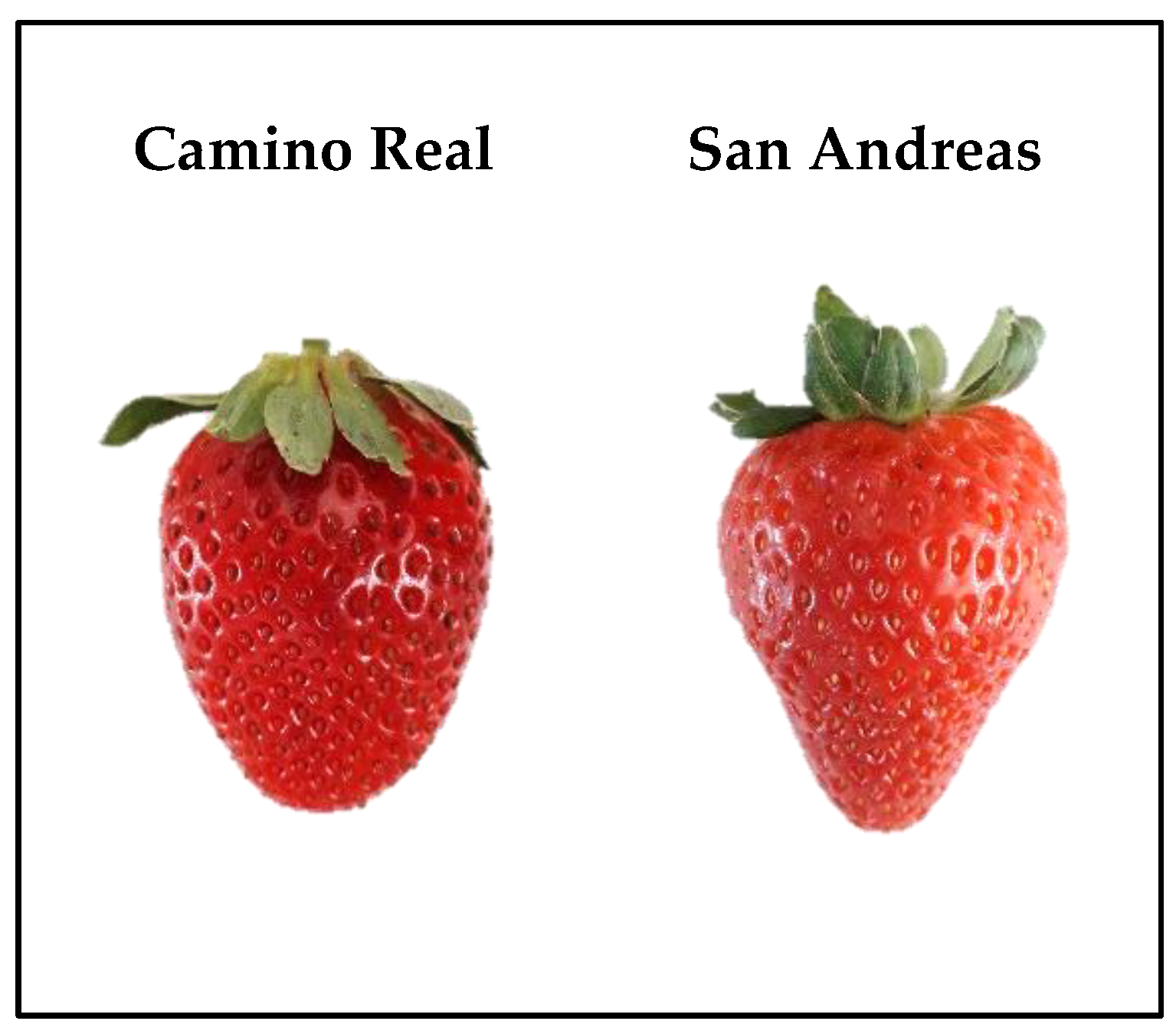
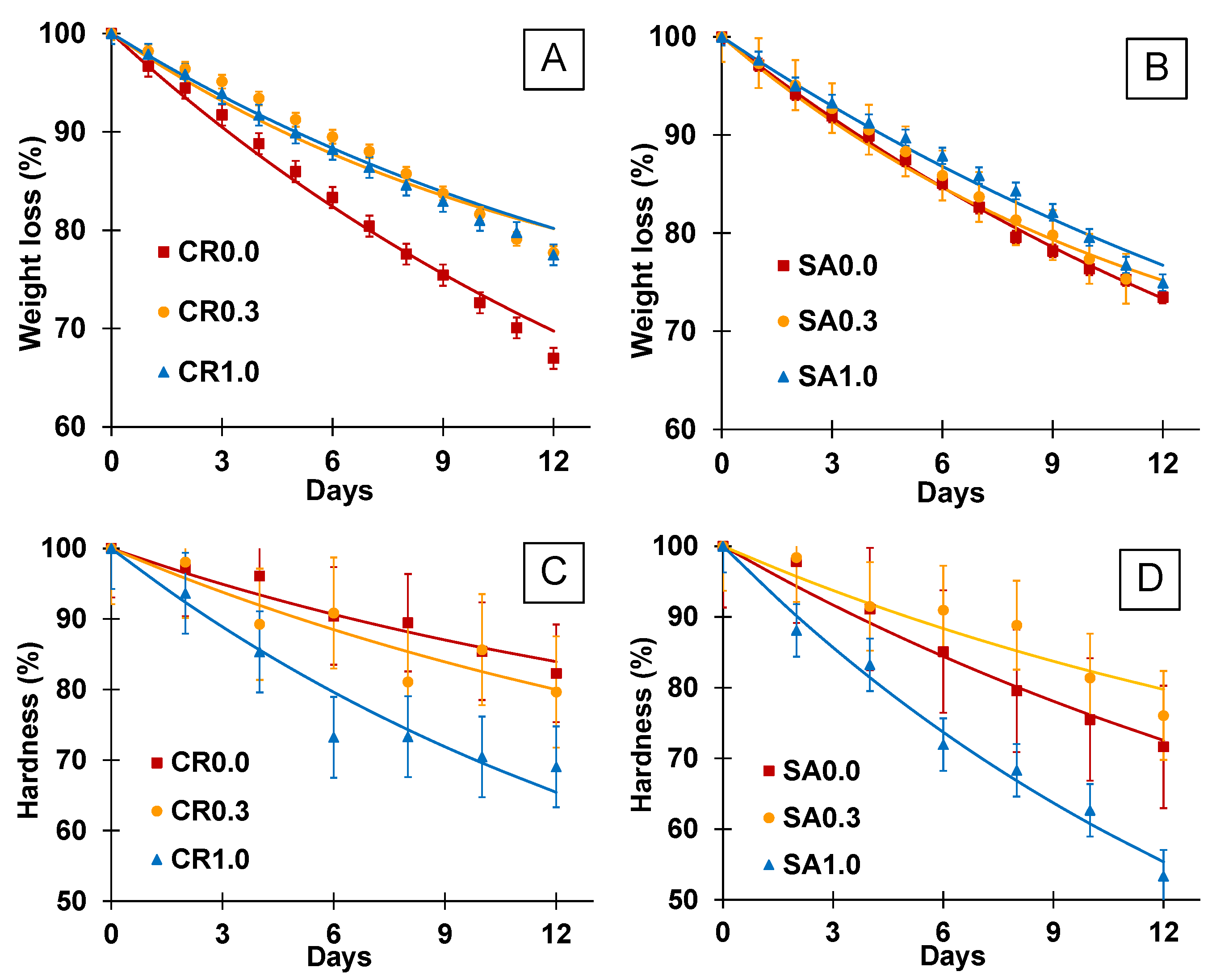

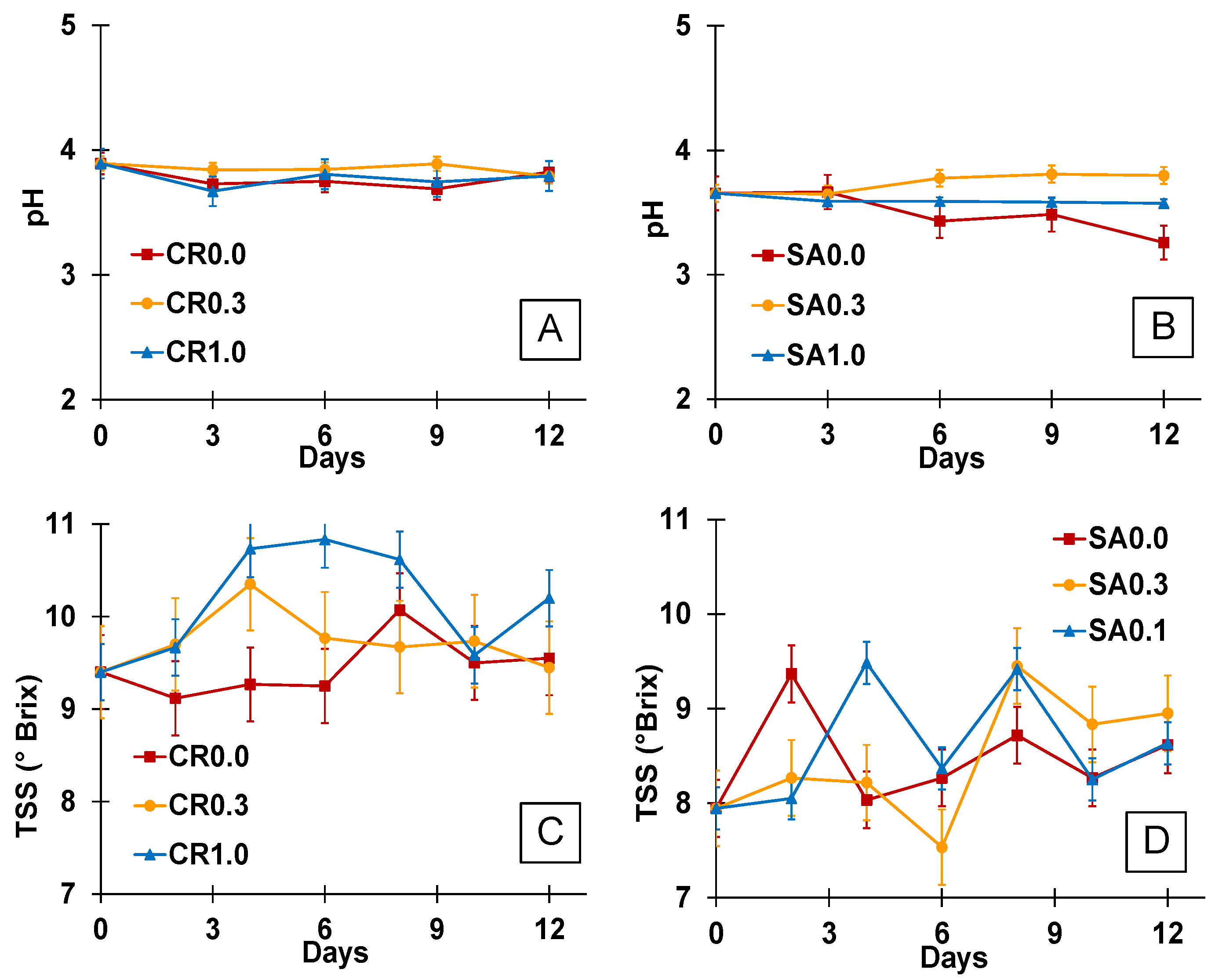
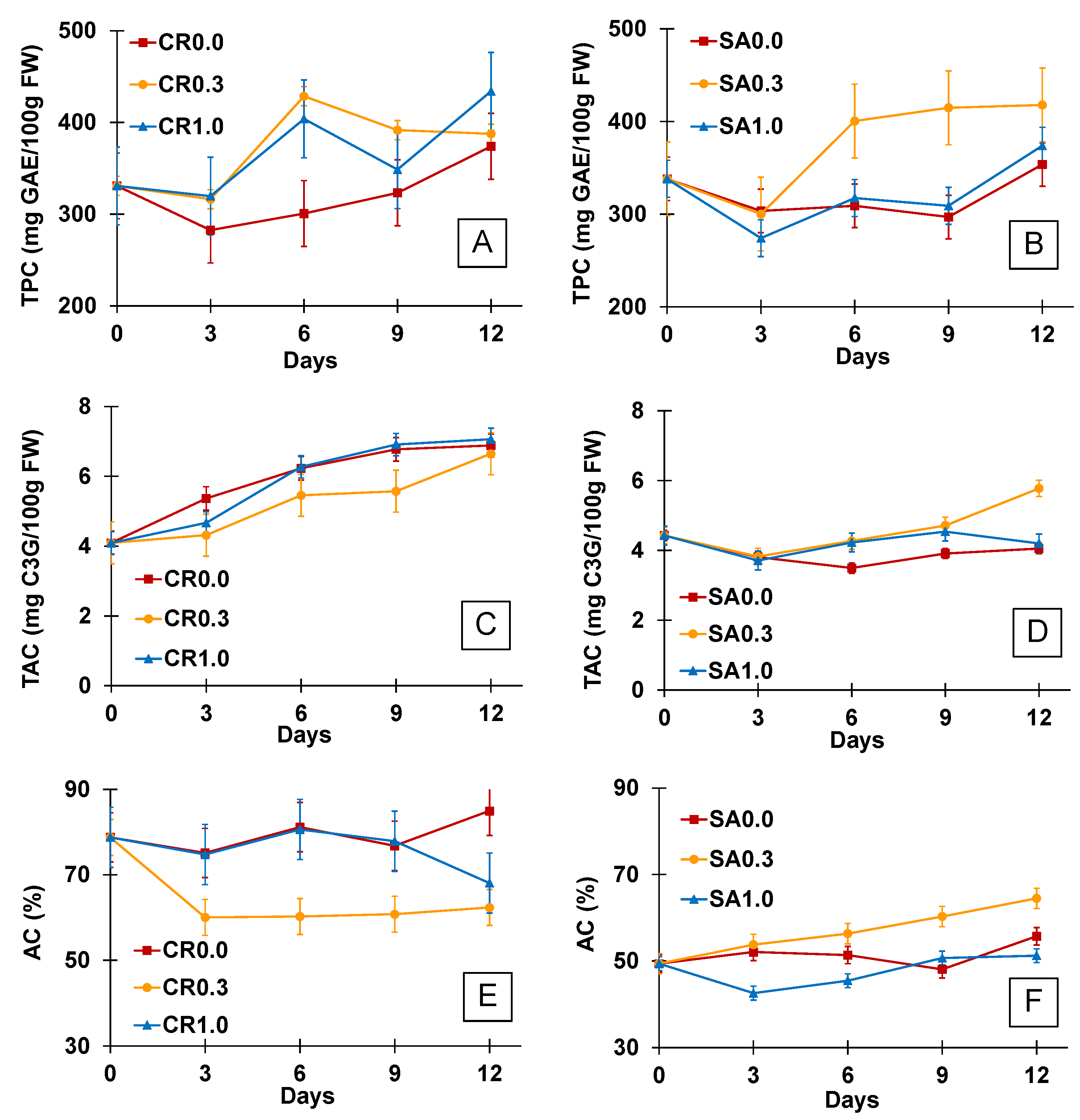
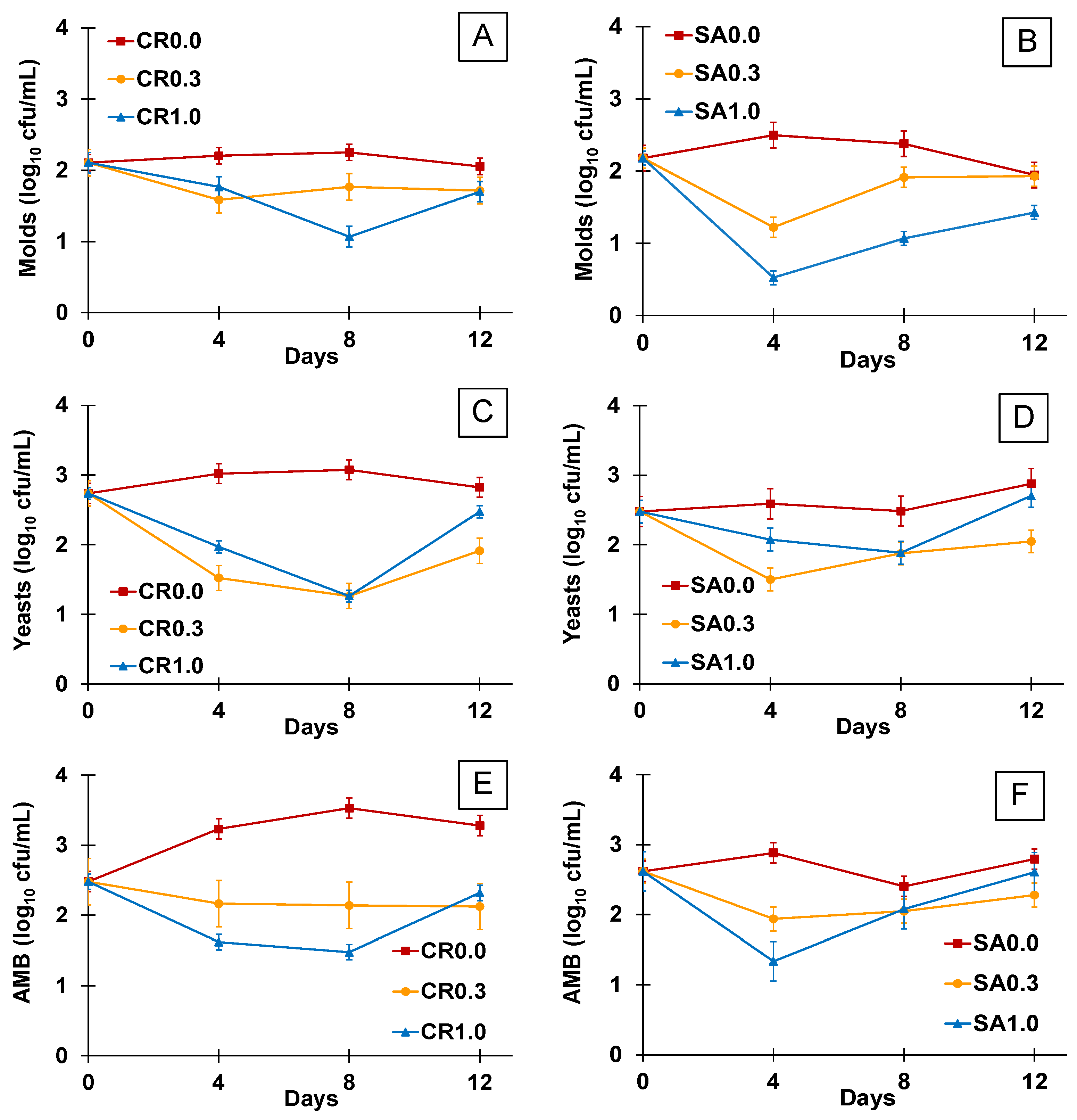
| Weight loss | Hardness | Lightness | Chroma | Hue angle | ΔE | pH | TSSs | |||||||||
|---|---|---|---|---|---|---|---|---|---|---|---|---|---|---|---|---|
| F | p | F | p | F | p | F | p | F | p | F | p | F | p | F | p | |
| MAIN EFFECT | ||||||||||||||||
| Ozone concentration (A) | 0.196 | 0.822 | 6.610 | 0.002 | 8.161 | 0.001 | 1.475 | 0.236 | 2.154 | 0.124 | 1.384 | 0.258 | 8.088 | 0.000 | 2.173 | 0.116 |
| Strawberry variety (B) | 3.105 | 0.083 | 50.259 | 0.000 | 40.268 | 0.000 | 107.260 | 0.000 | 38.527 | 0.000 | 0.250 | 0.619 | 34.357 | 0.000 | 69.671 | 0.000 |
| Storage time (C) | 719.344 | 0.000 | 18.337 | 0.000 | 231.219 | 0.000 | 215.272 | 0.000 | 14.980 | 0.000 | 283.658 | 0.000 | 1.197 | 0.315 | 2.382 | 0.030 |
| INTERACTIONS | ||||||||||||||||
| A × B | 4.234 | 0.019 | 10.648 | 0.000 | 1.047 | 0.357 | 1.112 | 0.335 | 0.380 | 0.685 | 8.278 | 0.001 | 2.401 | 0.094 | 1.610 | 0.202 |
| A × C | 7.184 | 0.000 | 1.118 | 0.345 | 0.506 | 0.788 | 1.262 | 0.259 | 0.936 | 0.517 | 1.838 | 0.070 | 1.306 | 0.245 | 1.088 | 0.372 |
| B × C | 3.530 | 0.040 | 0.414 | 0.870 | 2.446 | 0.071 | 0.303 | 0.890 | 1.753 | 0.099 | 0.957 | 0.432 | 0.907 | 0.461 | 0.838 | 0.542 |
| A × B × C | 1.597 | 0.189 | 0.266 | 0.994 | 1.080 | 0.375 | 1.220 | 0.283 | 1.379 | 0.163 | 1.347 | 0.220 | 1.079 | 0.381 | 0.778 | 0.673 |
| Parameter | Treatment | k (×10−2) [min−1] | Xeq | R2 |
|---|---|---|---|---|
| Weight loss | CR.00 | 5.50 ± 0.70 ax | 41.52 ± 1.55 ax | 0.99 |
| CR0.3 | 4.75 ± 0.35 ax | 62.18 ± 2.83 cx | 0.96 | |
| CR1.0 | 4.50 ± 0.00 ax | 55.02 ± 1.76 bx | 0.99 | |
| SA0.0 | 4.50 ± 0.00 ay | 35.65 ± 1.84 ay | 0.99 | |
| SA0.3 | 4.75 ± 0.35 ay | 55.78 ± 3.58 cy | 0.98 | |
| SA1.0 | 4.00 ± 0.00 ay | 36.45 ± 1.48 by | 0.97 | |
| Hardness | CR0.0 | 4.50 ± 0.00 ax | 60.87 ± 11.80 by | 0.91 |
| CR0.3 | 4.50 ± 0.70 ax | 51.48 ± 6.37 by | 0.67 | |
| CR1.0 | 5.25 ± 0.35 ax | 25.83 ± 8.59 ay | 0.87 | |
| SA0.0 | 4.00 ± 1.06 ax | 25.86 ± 6.91 bx | 0.80 | |
| SA0.3 | 5.00 ± 0.00 ax | 55.14 ± 0.70 bx | 0.88 | |
| SA1.0 | 6.50 ± 0.70 ax | 18.11 ± 2.36 ax | 0.83 | |
| Lightness | CR0.0 | 10.00 ± 0.00 ax | 70.63 ± 8.16 ax | 0.94 |
| CR0.3 | 12.25 ± 3.88 ax | 77.88 ± 10.92 ax | 0.95 | |
| CR1.0 | 15.00 ± 3.07 ax | 82.94 ± 11.13 ax | 0.95 | |
| SA0.0 | 15.00 ± 3.07 ax | 77.92 ± 2.33 ax | 0.94 | |
| SA0.3 | 15.00 ± 3.07 ax | 73.98 ± 10.08 ax | 0.98 | |
| SA1.0 | 20.00 ± 0.00 ax | 81.92 ± 2.66 ax | 0.99 | |
| Chroma | CR0.0 | 22.50 ± 5.31 ax | 66.47 ± 10.11 ax | 0.91 |
| CR0.3 | 12.50 ± 3.53 ax | 56.04 ± 14.82 ax | 0.86 | |
| CR1.0 | 9.50 ± 0.70 ax | 56.46 ± 14.38 ax | 0.93 | |
| SA0.0 | 17.00 ± 5.81 ax | 69.92 ± 2.89 ax | 0.93 | |
| SA0.3 | 19.50 ± 7.45 ax | 66.16 ± 12.94 ax | 0.94 | |
| SA1.0 | 20.00 ± 7.07 ax | 67.68 ± 4.79 ax | 0.94 | |
| ΔE | CR0.0 | 25.00 ± 0.00 bx | 14.80 ± 0.62 ax | 0.93 |
| CR0.3 | 25.00 ± 7.07 abx | 16.67 ± 1.08 ax | 0.91 | |
| CR1.0 | 10.00 ± 0.00 ax | 13.75 ± 0.30 ax | 0.95 | |
| SA0.0 | 15.00 ± 0.00 bx | 15.37 ± 0.11 ax | 0.92 | |
| SA0.3 | 12.50 ± 3.53 abx | 14.74 ± 0.10 ax | 0.83 | |
| SA1.0 | 20.00 ± 0.00 ax | 15.40 ± 0.23 ax | 0.92 |
| Bioactive Compounds | Microbiological Analysis | |||||||||
|---|---|---|---|---|---|---|---|---|---|---|
| TPC | TAC | AC | AMB | M and Y | ||||||
| F | p | F | p | F | p | F | p | F | p | |
| MAIN EFFECT | ||||||||||
| Ozone concentration (A) | 4.819 | 0.015 | 0.233 | 0.794 | 0.635 | 0.537 | 13.774 | 0.000 | 6.621 | 0.005 |
| Strawberry variety (B) | 0.447 | 0.509 | 26.756 | 0.000 | 29.861 | 0.000 | 5.236 | 0.031 | 0.925 | 0.346 |
| Storage time (C) | 0.762 | 0.558 | 4.917 | 0.004 | 0.185 | 0.944 | 0.554 | 0.651 | 1.918 | 0.154 |
| INTERACTIONS | ||||||||||
| A × B | 2.471 | 0.102 | 1.371 | 0.269 | 4.926 | 0.014 | 7.593 | 0.003 | 0.954 | 0.399 |
| A × C | 0.088 | 0.999 | 0.425 | 0.896 | 0.139 | 0.997 | 2.070 | 0.095 | 2.580 | 0.045 |
| B × C | 0.025 | 0.999 | 3.183 | 0.027 | 0.393 | 0.812 | 1.861 | 0.163 | 0.232 | 0.873 |
| A × B × C | 0.037 | 1.000 | 0.612 | 0.761 | 0.094 | 0.999 | 1.526 | 0.212 | 0.638 | 0.699 |
Disclaimer/Publisher’s Note: The statements, opinions and data contained in all publications are solely those of the individual author(s) and contributor(s) and not of MDPI and/or the editor(s). MDPI and/or the editor(s) disclaim responsibility for any injury to people or property resulting from any ideas, methods, instructions or products referred to in the content. |
© 2023 by the authors. Licensee MDPI, Basel, Switzerland. This article is an open access article distributed under the terms and conditions of the Creative Commons Attribution (CC BY) license (https://creativecommons.org/licenses/by/4.0/).
Share and Cite
Macías-Gallardo, F.; Barajas-Díaz, C.G.-M.; Mireles-Arriaga, A.I.; Ozuna, C. Strawberry Variety Influences the Effectiveness of Postharvest Treatment with Gaseous Ozone: Impact on the Physicochemical, Microbiological, and Bioactive Properties of the Fruit. Processes 2023, 11, 346. https://doi.org/10.3390/pr11020346
Macías-Gallardo F, Barajas-Díaz CG-M, Mireles-Arriaga AI, Ozuna C. Strawberry Variety Influences the Effectiveness of Postharvest Treatment with Gaseous Ozone: Impact on the Physicochemical, Microbiological, and Bioactive Properties of the Fruit. Processes. 2023; 11(2):346. https://doi.org/10.3390/pr11020346
Chicago/Turabian StyleMacías-Gallardo, Fabio, Carlos G.-M. Barajas-Díaz, Ana Isabel Mireles-Arriaga, and César Ozuna. 2023. "Strawberry Variety Influences the Effectiveness of Postharvest Treatment with Gaseous Ozone: Impact on the Physicochemical, Microbiological, and Bioactive Properties of the Fruit" Processes 11, no. 2: 346. https://doi.org/10.3390/pr11020346
APA StyleMacías-Gallardo, F., Barajas-Díaz, C. G.-M., Mireles-Arriaga, A. I., & Ozuna, C. (2023). Strawberry Variety Influences the Effectiveness of Postharvest Treatment with Gaseous Ozone: Impact on the Physicochemical, Microbiological, and Bioactive Properties of the Fruit. Processes, 11(2), 346. https://doi.org/10.3390/pr11020346







